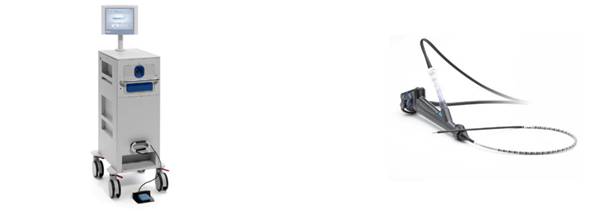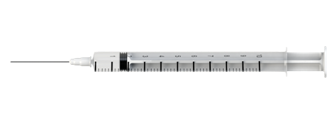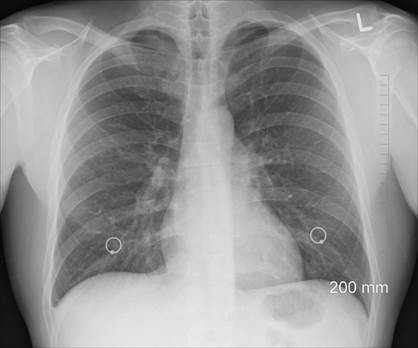Archives
Cryotherapy Spray For COPD Approved FDA
 In more FDA approval news, the U.S. Department Food and Drug Administrations (FDA) has designated a cryotherapy spray designed for the subset of patients with moderate to severe chronic obstructive pulmonary disease (COPD) who suffer from chronic bronchitis. Known as the RejuvenAir system, the device sprays liquid nitrogen at -196 degrees Celsius, aiming to rapidly freeze the epithelial layer of airway walls, destroying mucus-producing goblet cells while preserving the extracellular matrix that can regrow healthy cells.
In more FDA approval news, the U.S. Department Food and Drug Administrations (FDA) has designated a cryotherapy spray designed for the subset of patients with moderate to severe chronic obstructive pulmonary disease (COPD) who suffer from chronic bronchitis. Known as the RejuvenAir system, the device sprays liquid nitrogen at -196 degrees Celsius, aiming to rapidly freeze the epithelial layer of airway walls, destroying mucus-producing goblet cells while preserving the extracellular matrix that can regrow healthy cells.
The move by the FDA may signal acceleration of the availability of new treatments that leverage advanced technology. Use of these cryo-devices, which are meant to destroy unwanted tissue through the application of extreme cold, has been spreading across disease areas.
The FDA also gave RejuvenAir’s maker, CSA Medical, a separate unconditional investigational device exemption approval, which means the company can move forward with a study.
CSA Medical completed a feasibility study in 2018 and said in a press release that it plans to conduct a randomized, sham-controlled trial across 30 sites in the U.S., Europe and Canada with up to 330 patients. Small-scale initial safety data was published in the American Journal of Respiratory and Critical Care Medicine in 2017.
Cryotherapy has been safely used for some time in various medical procedures. The RejuvenAir System radial spray cryotherapy is for conditions associated with abnormal bronchial function, such as chronic bronchitis.
“We are eager to begin this pivotal trial and build on the successful data that was generated from the feasibility study of RejuvenAir,” Heather Nigro, senior vice president of regulatory, quality, and clinical affairs at CSA Medical, said in a press release. “Receiving the Breakthrough Device designation from the FDA further highlights the unmet clinical need for this patient population and we are excited to drive the solution for moderate to severe COPD patients with chronic bronchitis,” she said.
CSA Medical's already markets its truFreeze spray kit for use in patients with acid reflux, esophogeal cancer and other conditions.
With 8.6 million US diagnoses in the past year alone, chronic bronchitis is the most common disease to fall under the CPOD umbrella. Inflamed bronchial tubes lead to heavy mucus production and prolonged cough, and in some cases fatigue, shortness of breath and fever, which can be treated with a range of medications, oxygen therapy or surgical removal of damaged lung tissue.
FDA Approves Combination Therapy for COPD Maintenance
 The U.S. Food and Drug Administration (FDA) has approved a new therapy for chronic obstructive pulmonary disease (COPD) maintenance, a fixed-dose combination of the long-acting muscarinic antagonist (LAMA) aclidinium bromide (400 mcg) and long-acting beta-agonist (LABA) formoterol fumarate (12 mcg). The combination (Duaklir, Circassia) is administered twice daily via AstraZeneca’s breath-actuated inhaler (Pressair), Pharmacy Times reports.
The U.S. Food and Drug Administration (FDA) has approved a new therapy for chronic obstructive pulmonary disease (COPD) maintenance, a fixed-dose combination of the long-acting muscarinic antagonist (LAMA) aclidinium bromide (400 mcg) and long-acting beta-agonist (LABA) formoterol fumarate (12 mcg). The combination (Duaklir, Circassia) is administered twice daily via AstraZeneca’s breath-actuated inhaler (Pressair), Pharmacy Times reports.
The aclidinium bromide/formoterol fumarate therapy is expected to be launched in the United States in late 2019, according to a statement from Circassia. Its approval is based on broad clinical data from three Phase III studies.
Per the Pharmacy Times report, the medication therapy label includes clinical data from the Phase IV ASCENT study. “Aclidinium therapy is effective at reducing COPD exacerbations. As a result, the product is the only twice-daily LAMA/LABA in the United States with COPD exacerbation data included in its prescribing information,” according to a statement by Circassia.
The hope is the FDA approval of Duaklir will provide treatment for the significant number of patients with COPD in the US, according to a prepared statement from Steve Harris, Circassia’s chief executive.
“With guidelines recommending combined LAMA and LABA therapy for a number of COPD patient groups, we believe Duaklir will make an important contribution to the treatment of this debilitating disease,” said Michael Asmus, Circassia’s vice president, US Medical Affairs.
According to Circassia, Duaklir is presented as a dry powder for inhalation and is delivered via the breath-actuated multi-dose inhaler Pressair. Duaklir was initially approved in the European Union in 2014 and is approved in about 50 countries around the world under a number of brand names. In 2017 it completed a Phase III clinical study designed to support a regulatory filing in the US, which resulted in the product being approved in the US in March 2019.
Long-term use of statins reduces mortality, inflammation in COPD, review says
 A recent review showed that the long-term use of statins reduced the risk of acute exacerbation in chronic obstructive pulmonary disease (COPD), heart disease–related mortality and all-cause mortality, as well as decreased inflammatory factors. Statins are a group of drugs that act to reduce levels of fats, including triglycerides and cholesterol, in the blood.
A recent review showed that the long-term use of statins reduced the risk of acute exacerbation in chronic obstructive pulmonary disease (COPD), heart disease–related mortality and all-cause mortality, as well as decreased inflammatory factors. Statins are a group of drugs that act to reduce levels of fats, including triglycerides and cholesterol, in the blood.
Co-morbidities worsen outcomes in COPD, and the researchers noted that cardiovascular disease (CVD) is prevalent in patients with COPD. Pulmonary hypertension, in particular, is one of the most severe accompanying illnesses. Per reporting, the authors said there is a “growing understanding of systemic inflammation in a subset of patients with COPD,” and that high levels of C reactive protein (CRP) and IL-6 have been associated with poor outcomes.
The authors conducted an analysis to produce estimates of the effect of mortality, inflammatory factors and lung function index in COPD patients by searching four databases (PubMed, Web of Science, Embase, and China National Knowledge Infrastructure) between January 1990 to March 2018. They also conducted a network analysis to synthetically compare the effectiveness of using different statins in patients with COPD.
Out of 988 studies, the researchers settled on a 53 to use in the analysis that met several scientific pre-conditions. According to the analysis, using statins reduced the risk of all-cause mortality, heart disease-related mortality and acute exacerbation in COPD. It also reduced C reactive protein and pulmonary hypertension in COPD patients.
Analysis showed that fluvastatin (97.7 percent), atorvastatin (68 percent) and rosuvastatin (49.3 percent) had higher cumulative probability than other statins in reducing C reactive protein in COPD patients. Fluvastatin (76 percent) and atorvastatin (75.4 percent) had higher cumulative probability than other satins in reducing PH in COPD patients.
The researchers said their study answers whether statins can reduce inflammation and pulmonary hypertension, and which statin is more effective for COPD.
Flu Shot Crucial for Anyone With COPD
 Sufferers of chronic obstructive pulmonary disease (COPD) may benefit from a life-saving flu shot. While the benefits may make a real and significant difference in whether a person with COPD lives or dies, many of the millions with the lung condition simply don't get one, researchers report.
Sufferers of chronic obstructive pulmonary disease (COPD) may benefit from a life-saving flu shot. While the benefits may make a real and significant difference in whether a person with COPD lives or dies, many of the millions with the lung condition simply don't get one, researchers report.
The flu can bring about lung inflammation and it can flare up for those with COPD, making the infection worse, said lead researcher Dr. Sunita Mulpuru, an associate scientist at Ottawa Hospital in Canada.
The report was published in the January 2019 issue of the journal Chest.
About 10 percent die, and one in five develop critical illness requiring admission to the intensive care unit, Mulpuru said. However, getting a flu shot can lower the odds of being hospitalized for flu-related illness by 38 percent, her team discovered.
"Despite that finding, only 66 percent of the patients in this study were vaccinated,” Mulpuru noted.
Dr. MeiLan Han, a spokeswoman for the American Lung Association and a professor of internal medicine at the University of Michigan in Ann Arbor, said more COPD patients need to get vaccinated. “There are a lot of misconceptions out there,” Han said. “I hear things like 'I've never had the flu, so I don't think I'll ever get it,' which is a bit of a falsehood.”
During the 2018 flu season, about 1 million Americans went to the hospital, and the illness killed 80,000, the U.S. Centers for Disease Control and Prevention said.
For this specific study, Mulpuru said her team and colleagues collected data on nearly 4,200 COPD patients hospitalized for acute respiratory illness. After checking their flu vaccination status, investigators said they found that COPD patients who had a flu shot were 38 percent less likely to be hospitalized for flu-related illness.
Additionally, COPD patients with the flu were more likely to die than those without the disease (10 percent versus 8 percent). These patients were also more likely to be critically ill (17 percent versus 12 percent), the findings showed.
Patients most at risk were those over age 75, those with heart disease and those who needed to use oxygen at home, the researchers reported. Vaccination does reduce hospitalization in patients with COPD who contract influenza.
Is Daily Vitamin D a Lifesaver for COPD Patients?
 Patients with COPD might find some relief from lung attacks with a daily dose of vitamin D, new research suggests. Taking vitamin D supplements was associated with a 45 percent reduction in lung attacks among patients who were deficient in vitamin D, but there was no reduction among patients with higher vitamin D levels, the investigators found.
Patients with COPD might find some relief from lung attacks with a daily dose of vitamin D, new research suggests. Taking vitamin D supplements was associated with a 45 percent reduction in lung attacks among patients who were deficient in vitamin D, but there was no reduction among patients with higher vitamin D levels, the investigators found.
The study was published Jan. 10 in the journal Thorax.
Nearly all chronic obstructive pulmonary disease (COPD) deaths are because of a sudden worsening of symptoms (lung attacks), often triggered by viral upper respiratory infections, the researchers explained. “New treatments are urgently needed to prevent COPD attacks. Our study shows that giving supplements to vitamin D-deficient COPD patients nearly halves their rate of potentially fatal attacks,” said lead researcher Adrian Martineau, a professor at Queen Mary University of London.
In the study, Martineau and his colleagues analyzed data from 469 COPD patients from three clinical trials, which took place in the United Kingdom, Belgium and the Netherlands.
Around a fifth of COPD patients in the U.K. where the study took place – about 240,000 people – have low levels of vitamin D. Worldwide, more than 170 million people have COPD, and the disease caused an estimated 3.2 million deaths in 2015.
Vitamin D supplementation is safe and inexpensive, Martineau noted. "So this is a potentially highly cost-effective treatment that could be targeted at those who have low vitamin D levels following routine testing," he said in a university news release.
The researchers pointed out that since the data in their study came from just three trials, the findings should be interpreted with a degree of caution. Previous research from Queen Mary University found that vitamin D helps protect against colds, flu and asthma attacks.
Low Blood Levels of Vitamin D Linked to Increased Risk of Interstitial Lung Disease
 An estimated 20,000 individuals are diagnosed with interstitial lung disease (IDL) each year, which is characterized by lung scarring and inflammation that leads to progressive, disabling and irreversible lung damage. After analyzing the medical information of more than 6,000 adults over a 10-year period, Johns Hopkins researchers discovered that low blood levels of vitamin D were associated with an increased risk of early signs of ILD.
An estimated 20,000 individuals are diagnosed with interstitial lung disease (IDL) each year, which is characterized by lung scarring and inflammation that leads to progressive, disabling and irreversible lung damage. After analyzing the medical information of more than 6,000 adults over a 10-year period, Johns Hopkins researchers discovered that low blood levels of vitamin D were associated with an increased risk of early signs of ILD.
Researchers analyzed a series of studies to discover new, potentially treatable, factors related to early signs of the disease. For instance, CT scans may reveal abnormalities that are present before symptoms develop, which, in turn, can help to support future preventive strategies. The results of the most recent data analysis, which were published in the Journal of Nutrition, suggest that low vitamin D might be one factor involved in developing interstitial lung disease.
"We knew that the activated vitamin D hormone has anti-inflammatory properties and helps regulate the immune system, which goes awry in ILD," says Erin Michos, M.D., M.H.S., associate professor of medicine at the Johns Hopkins University School of Medicine and associate director of preventive cardiology at the Johns Hopkins Ciccarone Center for the Prevention of Cardiovascular Disease. "There was also evidence in the literature that vitamin D plays a role in obstructive lung diseases such as asthma and COPD, and we now found that the association exists with this scarring form of lung disease too."
Researchers used data from the Multi-Ethnic Study of Atherosclerosis (MESA), which recruited more than 6,800 individuals throughout the U.S. Throughout the participants' initial clinical visit, the medical staff took blood samples and measured, among other things, vitamin D levels. Participants also underwent heart CT scans throughout the study, which provided both incidental and partial views of the lungs. After ten years, 2,668 participants were given full lung CT scans evaluated for the prevalence of scar tissue or other abnormalities.
Patients with vitamin D-deficiency were documented to have had a larger volume of bright spots in the lung suggestive of damaged lung tissue. After reviewing the data from the full lung scans, researchers discovered that those with deficient or intermediate vitamin D levels had a 50 to 60 higher rate of abnormalities on their full lung scans that suggested early signs of ILD. Further, these associations were still prevalent even after adjusting for additional cardiovascular and inflammatory risk factors, including high blood pressure and cholesterol, diabetes and levels of high-sensitivity C-reactive protein.
"Our study suggests that adequate levels of vitamin D may be important for lung health. We might now consider adding vitamin D deficiency to the list of factors involved in disease processes, along with the known ILD risk factors such as environmental toxins and smoking," says Michos. "However, more research is needed to determine whether optimizing blood vitamin D levels can prevent or slow progression of this lung disease."
Diet Rich in Apples and Tomatoes May Help Repair Lungs of Ex-Smokers, Study Suggests
According to a study published in the European Respiratory Journal, a “natural decline in lung function over a 10-year period was slower among former smokers with a diet high in tomatoes and fruits, especially apples.” The researchers from Johns Hopkins Bloomberg School of Public Health suggest that their findings support the idea that certain components in these foods could aid in the restoration of lung damage caused by smoking.
 Throughout the study, it was discovered that adults who “ate more than two tomatoes or more than three portions of fresh fruit a day had a slower decline in lung function compared to those who ate less than one tomato or less than one portion of fruit a day.” When attempting to determine if other dietary sources, such as processed foods, containing these fruits and vegetables had the same effect, researchers discovered that the protective outcomes were “only observed in fresh fruit and vegetables.”
Throughout the study, it was discovered that adults who “ate more than two tomatoes or more than three portions of fresh fruit a day had a slower decline in lung function compared to those who ate less than one tomato or less than one portion of fruit a day.” When attempting to determine if other dietary sources, such as processed foods, containing these fruits and vegetables had the same effect, researchers discovered that the protective outcomes were “only observed in fresh fruit and vegetables.”
The study also revealed an association between a diet with high tomato consumption and a slow decline in lung function, even among adults who had stopped or never smoked.
"This study shows that diet might help repair lung damage in people who have stopped smoking. It also suggests that a diet rich in fruits can slow down the lung's natural aging process even if you have never smoked," said Vanessa Garcia-Larsen, assistant professor in the Bloomberg School's Department of International Health and the study's lead author. "The findings support the need for dietary recommendations, especially for people at risk of developing respiratory diseases such as COPD."
In 2002, the research team evaluated the diet and lung function of over 650 adults located throughout Germany, Norway and the United Kingdom. After ten years, they repeated lung function tests on the same participants. Each individual was prompted to complete questionnaires that assessed both their diet and “overall nutritional intake.”
The diet-lung-function association was even more prevalent among previous smokers who consumed a diet that was high in tomatoes and fruits. These individuals had an approximately 80 milliliter slower decline during the study, according to spirometry tests taken during the study period, a procedure that measures the capacity of lungs to take in oxygen. Researchers claim that these findings reveal the fact that these nutrients play a role in helping repair lung damage resulting from smoking.
"Lung function starts to decline at around age 30 at variable speed depending on the general and specific health of individuals," said Garcia-Larsen "Our study suggests that eating more fruits on a regular basis can help attenuate the decline as people age, and might even help repair damage caused by smoking. Diet could become one way of combating rising diagnosis of COPD around the world."
Click Here to Access the Full Article on ScienceDaily
$10 Million DNA Sequencing Effort Aims to Shed Light on Lung Diseases
Having received a $10 million donation from the National Heart, Lung and Blood Institute (NHLBI), the Washington University McDonnell Genome Institute will commence the sequencing of DNA from individuals with diverse ethnic backgrounds to better understand genetic roots that can lead lung disorders, including chronic obstructive pulmonary disease.
Most other large genome sequencing projects have focused on Europeans and Caucasians,” said principal investigator Susan K. Dutcher, PhD, a professor of genetics and the interim director of the McDonnell Genome Institute at Washington University School of Medicine. “With this program, we are including many people with other racial and ethnic backgrounds. Increasing the diversity of the groups being sequenced is important in understanding how genetic variations influence disease risk.”
 This study is part of a larger national initiative, NHLBI’s TOPMed program, which aims to “sequence and analyze the complete DNA – or whole genomes – of patients.” Researchers have the opportunity to use data from 62,000 participants involved in the program that were chosen based on their involvement with other studies, including the Framingham Heart Study.
This study is part of a larger national initiative, NHLBI’s TOPMed program, which aims to “sequence and analyze the complete DNA – or whole genomes – of patients.” Researchers have the opportunity to use data from 62,000 participants involved in the program that were chosen based on their involvement with other studies, including the Framingham Heart Study.
In an effort to reduce disparity-related sequencing efforts, the clinical trials in the analysis were specially chosen in a manner that would more closely mirror the diversity of the U.S. population and the genetic data present in individuals from underrepresented groups. Fifty percent of participants are of European descent, 30 percent are of African descent, 10 percent are of Hispanic or Latino origin, eight percent are of Asian descent, and approximately two percent represent indigenous populations.
“It’s also important that the total number of patients in the project is huge,” Dutcher said. “Early phases of TOPMed have already sequenced the genomes of 85,000 people. This year, for Washington University’s portion of the project, we’re sequencing the genomes of about 6,500 patients with lung diseases, primarily COPD and interstitial pulmonary fibrosis, a progressive scarring of lung tissue with variable causes, including autoimmunity.”
Researchers are ultimately seeking to understand how differences in DNA can contribute to disease risk. For instance, a variation in certain genes may increase the risk of developing a certain disease. Additionally, these studies may lead to the discovery of DNA variations that may protect against or decrease the risk of acquiring a particular disorder. These finding can be made possible with significantly large sample sizes that enable researchers to analyze DNA sequences in relation to patients’ diseases and compare those against healthy individuals for a more thorough understanding.
Click Here to Access the Full Article on Washington University School of Medicine in St. Louis
Study Reveals How HIV Virus Destroys Lung Tissue
A recent study published in Cell Reports exposes the damage human immunodeficiency virus (HIV) has on lung tissue. Weill Cornell Medicine researchers discovered a mechanism that could explain why nearly “30 percent of HIV patients who are appropriately treated with antiretroviral therapies” are later diagnosed with emphysema. Further, the study reveals how HIV binds to and transforms basal cells lining airways. These altered cells then release enzymes that can “destroy lung tissue and poke holes in walls of air sacs.”
“This research is important because although antiretroviral agents have turned HIV into a chronic, rather than deadly, disease, the viral reservoirs that remain in the lungs and other tissue continue to cause serious side effects,” said senior author Dr. Ronald Crystal, chairman of the Department of Genetic Medicine and the Bruce Webster Professor of Internal Medicine at Weill Cornell Medicine, and a pulmonologist at New York-Presbyterian/Weill Cornell Medical Center. “Now that we have more information about how the HIV virus might cause emphysema, we can learn more about this potential enzyme target and work toward developing a therapy to prevent this lung damage from happening.”
Although antiretroviral agents have helped to extend the lives of HIV-positive patients, they develop “degenerative disorders of the brain, heart and lungs” significantly more often than the general population. There are various explanations for this occurrence, including the belief that the antiretroviral drugs may in fact lead to these outcomes.
To gain insight, researchers exposed normal human airways basal cells, acquired from the lungs of nonsmokers, to HIV. Under observation, it was discovered that the virus “bonded to the basal cell’s surface and reprogrammed them to start producing an enzyme.” This enzyme then began to deteriorate proteins as well as destroy tissues. This finding is significant as emphysema originates in the airways, when basal cells are transformed due to the virus they begin to destroy healthy lung tissue which ultimately leads to emphysema.
“Our next step is to conduct additional research to determine what the preventive therapeutic target might be,” Crystal said, “And then, since basal cells are so important to normal lung anatomy and lung function, determine the other side effects of this re-programming.”
3 Travel Considerations If You Have a Lung Disease
Having a lung disease doesn’t have to hinder summer vacation plans. As temperatures continue to rise, the British Lung Foundation offers three key pieces of advice for individuals with lung disease who are planning to travel.
Transportation
It is essential to prepare for any special transportation-related accommodations that will be needed. Whether traveling by plane, bus, train or ship, the operator should be contacted ahead of time if an individual is traveling with oxygen. Each transportation provider has varying oxygen policies and may require travelers to bring special equipment. Determining if wheelchair access or assistance is provided to assist individuals boarding or leaving the vehicle is also another factor to plan for.
Location
Location can have a significant impact on traveling. An individual’s healthcare team should be consulted before planning a vacation to ensure they can safely travel to specific destinations. For instance, “places at high altitudes may cause problems for people with lung diseases as their lungs will need to work much harder to breathe.” The terrain also impacts the ability to physically travel. Individuals must consider the availability of oxygen and medical assistance while visiting certain locations.
Medication
It is advised to take all required medications for the duration of the trip, as well as “extra in case of emergencies.” The British Lung Foundation also recommends taking a list of all required medications to show medical professionals in the case that an individual falls ill during the trip.




